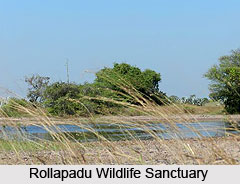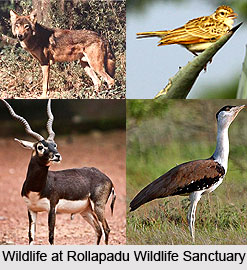 Rollapadu Wildlife Sanctuary, situated in the Kurnool district of the Indian state Andhra Pradesh is famed for being the home for the critically endangered species, Great Indian Bustard. It encompasses an area of 6.14 square kilometres and lies near the border of the state with Karnataka. It was established in the year 1988 with the aim of conserving the Lesser Florican and the Great Indian Bustard. It is also known to be the only habitat in the state for Bustard. However in recent years a drastic fall has been recorded in the number of this species.
Rollapadu Wildlife Sanctuary, situated in the Kurnool district of the Indian state Andhra Pradesh is famed for being the home for the critically endangered species, Great Indian Bustard. It encompasses an area of 6.14 square kilometres and lies near the border of the state with Karnataka. It was established in the year 1988 with the aim of conserving the Lesser Florican and the Great Indian Bustard. It is also known to be the only habitat in the state for Bustard. However in recent years a drastic fall has been recorded in the number of this species.
Geography of Rollapadu Wildlife Sanctuary
Rollapadu Wildlife Sanctuary mainly comprises undulating plains having hot and dry climate. The rainfall in the region is quite inconsistent and uneven. The average annual rainfall in the sanctuary is about 450 mm. The average elevation of the place is about 290 metres.
Flora of Rollapadu Wildlife Sanctuary
Rollapadu Wildlife Sanctuary primarily constitutes a grassland ecosystem featuring thorny bushes and mixed forest. Agricultural lands border the sanctuary where sunflower, tobacco and cotton are cultivated.
 Fauna of Rollapadu Wildlife Sanctuary
Fauna of Rollapadu Wildlife Sanctuary
Rollapadu Wildlife Sanctuary hosts a plethora of faunal and avifaunal species. Common species found here include Rattlesnakes, Indian Cobra, Russell`s Viper, Black Buck, Sloth Bear, Jungle Cat, Bonnet Macaque, Jackal and Fox. It is also the home to about 132 species of birds. Alganur reservoir located near the sanctuary serves as a refuge for migratory birds. Apart from the Bustard and the Florican, other species commonly found here include migratory species like Greater Flamingo, Demoiselle Crane and Barheaded Geese and other birds such as Short Toed Snake Eagle, Myna, Indian Roller and many others. In recent years an increase in the Black Buck population has been recorded which is one of the prime reasons of deteriorating numbers of Bustard and the Florican. They also feed on grasses which have resulted in a drop in the number of Locusts and Grasshoppers which serve as significant food source for the two birds.
Threats to Rollapadu Wildlife Sanctuary
Rollapadu Wildlife Sanctuary is presently facing severe threats from various sources. The large population of Black Bucks found in the sanctuary often raid the farmlands near the sanctuary which has resulted into the issue of public anger against the sanctuary. Breeding of Bustards have been affected by the cattle grazing inside the sanctuary. Linking of Alganur tank with the Telugu Ganga Canal has resulted into rise in ground water level which is contributing in alteration of ecosystem of this semi-arid region bringing about changes in flora and agricultural crops cultivated near it. Owing to the biomagnification, Harriers have been found dead. The population of Short-Toed Larks, Lesser Florican and Foxes have also depleted considerably here.
Visiting Information
The best time to visit Rollapadu Wildlife Sanctuary is from October to April. Nearest Railway Station is Kurnool which is about 45 kilometres form the sanctuary. From Kurnool the place can be reached by road. Nearest airport is located in Hyderabad. Forest rest house is available for tourist accommodation in Kurnool.



















